 |

|
|
|
Welcome to the March 2014 Newsletter from KAFS
 | | Dear Member, we will be sending a Newsletter email each month to keep you up to date with news and views on what is planned at the Kent Archaeological Field School and what is happening on the larger stage of archaeology both in this country and abroad. Talking of which we are extremely lucky this year to be able to dig with the University of Texas at Oplontis just next door to Pompeii. |
The 25 people that have booked will have amazing memories to take home with them! The Study Days are proving extremely popular with the trip to view the Staffordshire Hoard fully booked, and Stonehenge has two places left with Roman Bath (above) three. At home we are digging the last of three Bronze Age round barrows at Hollingbourne in Kent where last year in Barrow 2 we found a crouched burial and a complete bovine burial.

 | | Work will continue on two
Roman villa estates, one at Abbey Farm in Faversham, the other at Teston located above the River Medway close to Maidstone (left).
So, look at our web site at www.kafs.co.uk for details of courses and ‘behind the scenes’ trips with KAFS. Please pass this E-Newsletter on to your friends and colleagues- they can also sign up on the Home Page of the KAFS Website. |
If you are not a member sign up soon or you may miss out on the experience of a lifetime, and please pass on to your friends!
Paul Wilkinson
[email protected]
MUST SEE
The British Museum has opened the Sainsbury Exhibitions Gallery with a major exhibition on the Vikings.
The extraordinary Viking expansion from the Scandinavian homelands during this era created a cultural network with contacts from the Caspian Sea to the North Atlantic, and from the Arctic Circle to the Mediterranean. The Vikings will be viewed in a global context that will highlight the multi-faceted influences arising from extensive cultural contacts.

The exhibition will capitalise on new research and
thousands of recent discoveries by both archaeologists and metaldetectorists,
to set the developments of the Viking Age in context.
These new finds have changed our understanding of the nature of
Viking identity, trade, magic and belief and the role of the warrior in
Viking society. Above all, it was the maritime character of Viking
society and their extraordinary shipbuilding skills that were key to
their achievements. At the centre of the exhibition will be the
surviving timbers of a 37-metre-long Viking warship, the longest ever
found and never seen before in the UK. Due to its scale and fragility it
would not have been possible to display this ship at the British
Museum without the new facilities of the Sainsbury Exhibitions
Gallery.
The ship, known as Roskilde 6, was excavated from the banks of
Roskilde fjord in Denmark during the course of work undertaken to develop the Roskilde Viking Ship Museum in 1997.

Since the
excavation, the timbers have been painstakingly conserved and
analysed by the National Museum of Denmark. The surviving timbers
– approximately 20% of the original ship - have now been reassembled
for display in a specially made stainless steel frame that
reconstructs the full size and shape of the original ship. The
construction of the ship has been dated to around AD 1025, the high
point of the Viking Age when England, Denmark, Norway and
possibly parts of Sweden were united under the rule of Cnut the
Great. The size of the ship and the amount of resources required to
build it suggest that it was almost certainly a royal warship, possibly
connected with the wars fought by Cnut to assert his authority over
this short-lived North Sea Empire.
Weapons and looted treasures demonstrate the central role of warfare
to the identity of the Vikings. Recently excavated skeletons from a
mass grave of executed Vikings near Weymouth in Dorset will provide a close-up
 | | encounter
with ‘real’ Vikings and illustrate
what happened when things
went wrong for Viking warriors
on British soil.
The Vale of York Hoard will be
shown in its entirety at the
British Museum for the first time since it was discovered by metal detectorists near Harrogate in |
2007 and jointly acquired by the British Museum and York Museums
Trust. Consisting of 617 coins, 6 arm rings and a quantity of bullion
and hack-silver the Vale of York Hoard is the largest and most
important Viking hoard since the Cuerdale Hoard was found in
Lancashire in 1840, part of which will also be included in the
exhibition. With coins and silver from places as far removed as
Ireland and Uzbekistan, the hoards reveal the true extent of the Viking
global network. The silver cup in which the Vale of York Hoard was
buried predates the burial by a century and was probably made for use
in a Frankish church. It may well represent treasure stolen in a Viking
raid.

The Vale of York hoard includes objects coming from as far apart as
Afghanistan in the East and Ireland in the West, as well as Russia,
Scandinavia and continental Europe. Represented in the hoard are
three belief systems (Islam, Christianity and the worship of Thor) and
peoples who spoke at least seven languages.

Ostentatious jewellery of gold and silver will demonstrate how status
was vividly displayed by Viking men and women. These include a
stunning silver hoard from Gnezdovo in Russia, never previously seen
in the UK, which will highlight the combination of Scandinavian,
Slavic and Middle Eastern influences which contributed to the
development of the early Russian state in the Viking Age.
Neil Macgregor, Director of the British Museum said “The reach and
cultural connections of the Viking Age make it a remarkable story
shared by many countries, not least here in the British Isles. New
discoveries and research have led to a wealth of new information
about the Vikings so it is a perfect moment to look again at this
critical era. Temporary exhibitions of this nature are only possible
thanks to external support so I am hugely grateful to BP for their
longstanding and ongoing commitment to the British Museum.”
Follow updates on the exhibition via Twitter on #Vikings Exhibition
and the Museum’s Twitter account @britishmuseum
Tickets can be booked online at britishmuseum.org or 020 7323
8181.Opening hours 10.00–17.30 Saturday to Thursday and 10.00–
20.30 Fridays. Open on Good Friday 18 April, 10.00–17.30.
STUDY DAYS
Staffordshire Hoard KAFS Visit on Friday 9th May at 10.00am.
Birmingham Museum and Art Gallery with, Dr David Symons,
Curator of Antiquities and Numismatics (FULLY BOOKED).

Summer sunrise from inside the stones of Stonehenge with Dr Paul Wilkinson Friday 23rd May.
£75 for members with only ten places available
05.15 Meet at the new Visitor Centre
05.30 Entrance to the centre of the stones to watch for that magical moment of sunrise
07.00 Breakfast at the nearby Little Chef
09.00 Return to the Stonehenge Visitor Centre for a comprehensive tour of the new facility with an opportunity to re-visit the stones and walk along the Avenue, the original approach to Stonehenge and visit the Stonehenge cursus and the magnificent round barrows on King Barrow Ridge
12.00 Lunch
1.00 Visit to Durrington Walls and Woodhenge
3.00 Summing up and disperse
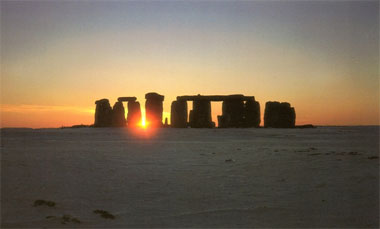
For a take on the present state of Stonehenge and its new Visitor Centre Richard Morrison writing in the Times said:
‘Tomorrow, of course, is the biggest day of the year, as well as the shortest. It's the Winter Solstice, the moment when Stonehenge is perfectly aligned with the rising and setting sun. The hippies and "druids" may mostly prefer to gather there at midsummer, but the evidence suggests that for our Neolithic ancestors, who spent millennia worshipping there, the winter ritual was more important.
It is for me as well!
During the summer this part of Salisbury Plain fits Ernest Thesiger's famous remark about the First World War: "My dear, the noise, the people!" You can't move for coach parties — literally, if you are jammed on the permanently clogged A303. Whereas in midwinter, half shrouded in mist or lashed by rain, Stonehenge looks just as it should: gaunt, desolate, elegiac, enigmatic.
Almost, in fact, as Constable painted it in 1836: "remote on a bare and boundless heath". The heath isn't quite "bare and boundless" these days. But this week English Heritage (EH) and the National Trust (which respectively manage Stonehenge and the land around it) took a giant step towards returning some prehistoric calm to this landscape.
On Wednesday [17th December 2013] EH opened its new visitor centre. That sounds prosaic in the context of a 4,300- year-old monument, but this fine Denton Corker Marshall creation in wood and glass represents a huge advance in how Stonehenge is understood by the million people who visit it each year. For a start, the visitor centre, and all its attendant car parks, is 1.5 miles from the monument itself. The old visitor centre, now being demolished, was a pile of Sixties crud and commercialism right by the stones. By next June all traces of its sorry existence will be grassed over, as has already happened to the old A344 which ran right past the stones. Instead, visitors will be driven to the stones in shuttles. Or, better, they will walk across the Plain, perhaps taking in the Avenue and Cursus: the ancient processional path and earthworks round Stonehenge. As important as the landscape's restoration, however, is the exhibition inside the new visitor centre. As Simon Thurley, EH's boss, says: "Over the past ten years our understanding of this place in Neolithic times has been transformed. We had thought this was an empty landscape, where people came for ceremonies. Now we have discovered the people, what they ate and wore, and even how they did their hair." All of that is incorporated in an exhibition that will blow the mind of anyone interested in our isles' prehistory. Here are the stone, flint and animal-bone tools that shaped Stonehenge in that pre- Bronze Age, the sacred jewellery, cups and axes buried in the mounds, and, most spectacular and controversial of all, a skeleton of an early Neolithic man, found just a mile away.

What's more, his face has been reconstructed with the help of modern marvels such as isotope analysis. (Pity he ends up looking like Mel Gibson in Braveheart — but don't they all?) In a few months, too, a Neolithic village will also be reconstructed, based on houses just excavated three miles from Stonehenge.
The exhibition also contains a 360-degree film showing what it must have been like to stand inside the circle when it was complete (if it was ever complete), as well as documents showing how Stonehenge has been explained over the past 900 years.
We may laugh at the medieval belief that the stones were magicked from Ireland by Merlin, or at Inigo Jones's drawing of the "Roman temple" he thought the stones supported — but we are far from knowing all the answers. As Thurley says, however, we do know so much more than we did a decade ago. So although the years of dithering in sorting out this site have been frustrating, the delay has paradoxically worked to the advantage of scholars, tourists and taxpayers alike. Had the grandiose Stonehenge project mooted back in 2003 gone ahead, the visitor centre would have cost £75 million, with another £200 million required to put the A303 in a tunnel. This present scheme has cost just £27 million — not a penny provided by Government — and visitors will benefit from the astounding discoveries of the past few years. In short, a triumphant compromise snatched from the jaws of muddle and procrastination. Very British.
Richard Morrison
To join the ‘behind the scenes’ visit with KAFS on Friday 23rd May 2014 email your booking to [email protected]. Places available for ten members only at £75 per person.
A day in Bath followed by a Twilight Tour & Dinner in the Roman Baths. KAFS Visit on Saturday 13th December at 9.30am with Stephen Clews Curator of the Roman Baths.
9.30 Introductory talk by Stephen Clews
10.45 Visit to the Pump Room for spa water
11.15 Visit the Roman Baths site, including special access to underground passages not open to the public
12.30-1.30 Lunch break
1.30 Tour of old spa buildings and Bath's Georgian upper town
4.30 Meet your evening guide at the Great Bath for an exclusive guided tour around the torchlit baths followed by a three course dinner at the Roman Baths Kitchen

A day in the beautiful Cotswolds and the graceful city of Bath will reveal the Roman heritage of the area. Our tour leader will be Stephen Clews, Curator of The Roman Baths for the last 16 years, and prior to that Assistant Curator at the Corinium Museum in Cirencester.
The study day begins with an introductory talk by Stephen Clews followed by a gulp of spring water in the Great Pump Room at Bath. Then we visit the Roman Baths and Temple complex built around the hot springs of Bath, which became a place of pilgrimage in the Roman period. This tour will include special access to underground passages and the spa water borehole. The spa theme will continue as we trace the story of seven thousand years of human activity around the hot springs, which has created this World Heritage city. The afternoon will conclude with a walk around the Georgian upper town.
In the early evening we meet up at the Roman Baths for a torchlit guided tour of the Roman Bath Museum followed by Dinner at the Roman Baths Kitchen opposite the main entrance to the Roman Baths.
To join the ‘behind the scenes’ visit with KAFS on Saturday 13th December 2014 email your booking to [email protected]. Places available for ten members only at £75 per person.
FIELD TRIPS
Join KAFS on a field trip on 26th-28th September 2014 to Zeugma. It is a not a trip for the light-hearted but there are direct flights by Turkish Airlines direct to Gaziantep from Gatwick at about £250 return. Local accommodation and a local mini-bus plus local guide will be available and Dr Paul Wilkinson will be your guide. We have nine places left, mini-bus and museum costs to be shared among members. For more details email Paul Wilkinson [email protected]

The ancient city of Zeugma was originally founded as a Greek settlement by Seleucus I Nicator, one of the generals of Alexander, in 300 BC. King Seleucus almost certainly named the city Seleucia after himself; whether this city is, or can be, the city known as Seleucia on the Euphrates or Seleucia at the Zeugma is disputed. The population in the city at its peak was approximately 80,000.

In 64 BC Zeugma was conquered and ruled by the Roman Empire and with this shift the name of the city was changed into Zeugma, meaning "bridge-passage" or "bridge of boats". During Roman rule, the city became one of the attractions in the region, due to its commercial potential originating from its geo-strategic location because the city was on the SilkRoad connecting Antioch to China with a quay or pontoon bridge across the river Euphrates which was the border with the Persian Empire until the late 2nd century.
Museums we will visit include:
• Archaeological Museum This local archaeological museum hosts some stunning mosaics excavated from the nearby Roman site of Zeugma. The museum, which also has a small cafe inside, is wheelchair accessible.
• The Castle's Museum It is a great opportunity to learn from the Turkish point of view what happened in the WWI, especially what concerns to the dissolution of the Ottoman Empire and the further occupation. The view from the top of the castle is amazing.
• Kitchen Museum Museum about Turkish traditional cuisine, food, ingredients, tools and bon tòn. Very interesting.
• Zeugma Mosaic Museum Zeugma Mosaic Museum, in the town of Gaziantep, Turkey, is the biggest mosaic museum on the world, containing 1700m2 of mosaics.
For more information on Zeugma see: http://www.zeugmaweb.com/zeugma/english/engindex.htm
BREAKING NEWS
A strange tale is unfolding in Kent of a secret site, gold treasure and
social media arguments on what is going on and what, if any is KCC
Heritage archaeologists’ involvement. It seems the site is somewhere along the
M20/A20 intersection
and it is said it was a metal
detectorists’ rally which hit gold
which then seems to have got out
of control. We await an informed,
transparent account from the Finds
Officer for KCC on exactly what
happened, and what is going to
happen. Unfortunately it seems
like a re-run of the finding by a
metal detectorist of the gold
Ringlemere Cup some years ago. | |  |
Top discoveries of 2013
 | | Richard Ill's bones were the top
archaeological story of 2013, the
American magazine Archaeology
proclaimed this month.
Discoveries in Ireland, Egypt and
Cambodia are also among the best
ten finds worldwide, it said.
Richard Buckley, who directed
the dig in Leicester, said: "We
could say beyond
Reasonable doubt it was Richard
III." Archaeology couples this
confirmation — the skeleton was found in 2012 under a council car park, and the final disposition of the royal remains is still subject to legal dispute |
— with the
identification in 2010 of Bosworth Field a mile from its traditional
location: remains of weapons, armour, cannonballs and a Yorkist
silver badge found by metal detectorists and mapped by Dr Glenn
Foard pinned down the real site of the end of medieval England.
Richard III may turn out to be one of the top stories of 2014 as well:
his ceremonial reinterment has been delayed until late in the summer
because of the current judicial review of where he should be buried.
This is allowing scientists to sequence his complete genome, and the
results of analysis of his nuclear
Y-chromosome DNA are expected shortly. Y-DNA descends in the
male line: earlier analysis of the skeleton's mitochondrial DNA, which
is passed from down the generations from mother to daughter,
supported its identification as Richard Ill's by comparison with the
mitochondrial DNA of a 17th-generation collateral descendant. The
other result awaited is that of strontium- isotope analysis of the tooth
enamel: because our teeth are formed in childhood, the isotopic
content of the water where we then lived is locked into our dentition.
Four years ago the ratio of strontium-87 to -86 in the bones of
Eadgytha, Alfred the Great's granddaughter, buried in Magdeburg
Cathedral in Germany, proved that it was indeed her because of a
childhood spent in the chalk hills of Wessex.
Another ancient corpse, the oldest known bog body, found in Cashel
Bog in central Ireland, also makes the top ten. Most such finds,
including the famed Tollund Man and Grauballe Man in Denmark,
date to the late centuries BC in the pre-Roman Iron Age, and Britain's
best-known bog sacrifice, Lindow Man, was ritually murdered
sometime in the decades around the Roman conquest of AD43.
"Cashel Man" provided a surprise when radiocarbon dating revealed
that he had died around 2000BC, hacked to death with a bronze axe,
and pushes back this ritual by one and a half millennia. Much later but
equally grisly evidence comes from Jamestown in Virginia, where the
starving English settlers in the winter of 1609-10 went so far "as to
digge upp deade corpses outt of graves and to eate them", according
to a coeval source now borne out by the discovery of a butchered
14-year-old girl's skull, found in a pit alongside the bones of horses
and dogs also slaughtered for food.
Other discoveries to make the list include the earliest Egyptian port, at
Wadi el-Jarf south of Suez, where boat fragments and ropes dating to
around 2500BC were found in a storage chamber, together with
remains of a stone jetty and anchors. Slabs with the name of the
pharaoh Khufu (Cheops, 2551-2528 BC), builder of the Great
Pyramid at Giza, put the ancient port a millennium earlier than the
famous Red Sea site of Wadi el-Gawasis.
Technology supplies one of Archaeology's most spectacular listings:
the ancient Khmer city of Angkor in Cambodia is covered by tropical
forest, with only the major temple complexes such as Angkor Wat
and the Bayon being easily visible. A form of airborne radar known as
Lidar uses wavelengths that cut through the forest to reveal the
abandoned cities beneath, including residential areas laid out along
grids of streets. Angkor Thorn has quadrupled in size, to over 13
square miles, and proves to have been "a dense urban core surrounded
by a vast lower-density periphery or sprawl", analogous to
"megacities" such as Los Angeles, according to Dr Damian Evans, of
the University of Sydney. Similar results have been obtained by Lidar
surveys of Maya cities, including Caracol in Belize, and the further
application of this technique (initially used on Iron Age hillforts in
Germany) may well supply Archaeology magazine with some of its
top discoveries of 2014.
Norman Hammond writing on Archaeology 67 no. 1:24-30
Greek statue retrieved from the sea!
Jack Malvern writes that the discovery of an ancient bronze statue of
Apollo should be a cause for celebration among archaeologists and
represent a windfall for its finder worth millions of pounds, but there
is just one snag: the sculpture, one of a handful to survive from
antiquity, cannot be sold, inspected or even exhibited, because it was
found in the Gaza Strip.
 | | Experts who have seen photographs of the 6ft (1.8m) statue called it a
"major discovery", and
believe that it was
forged at some point
between the 5th century
BC and the 2nd century
AD.
Unusually, its feet are
intact and it has retained
one of its eyes.
It could fetch up to £17
million if sold at
auction, but the political situation is so fraught |
that it may never be allowed
to leave Gaza. It is also unlikely to go on display because Hamas, the
political authority holding it, regards the anatomically correct nude as
both obscene and an idol.
The discovery was claimed by a fisherman, who says he found the
statue about 100 metres from the shore at Deir al-Balah, a city eight
miles southwest of Gaza City, although this was disputed by one
expert. Jouda Ghurab, who claims to have spotted the statue on
August 16 last year, told Bloomberg International that he was
catching bream when he noticed an unusual movement of the current.

"The rocks looked strange," he said. "The underwater waves had dug
the sand and moved it out." Anxious not to miss Friday prayers, he
says he took a bearing from a building and returned to shore,
returning later with six men, a boat and a length of clothes line. The
boat almost sank as they tried to lift the statue; he said, but they found
that they could flip it end over end along the sea floor until they
reached the beach.
Among the crowd that quickly gathered were members of the al-
Qassam Brigades, the militant wing of Hamas, who took it away.
They were in turn obliged to give it up when the Hamas police force
arrived, leading to an armed stand-off that only ended when more
senior police officers came to negotiate. The statue is being held in an
office run by the Hamas interior ministry at a secret location in Gaza.
Even if Mr Ghurab's story can be verified, it is likely that the statue
would be subject to claims by Hamas, Israel and Palestinian
Authority, who were led by Hamas in 2007. Hamas is registered as a
terrorist organisation by the European Union and the United States,
'Thomas Bauzou, a professor of ancient history at the University of
Orleans in France, believes that the statue is a major discovery but has
doubts that it was found in the sea. "This story has been fabricated to
hide the real place where the statue was found so they can continue
digging," he suggested.
Muhammad Ismael Khillah, an under-secretary at the ministry,
believes that the statue could help to ease political relations if it could
be lent to a foreign museum. "We are keeping the door open to cooperation
with any government," he said.
He also suggested that it could be displayed in Gaza. "We will have to
cover it in certain places," he said.
Why the Ark myth weathers the storms of time.
Ben Macintyre writes: As the rain pours and the flood waters rise, do
you feel the urge to build a boat and sail away? Does some part of you
feel that the endless downpour, changing the very contours of the
Earth, is in some way a punishment for self-indulgence when the sun
was shining? Do you long to leave behind sodden reality and start
again, taking your pets with you?

If so, you are suffering from Ark syndrome, a psychological urge
buried deep in our cultural DNA, one of the very few universal
stories, and probably the only example of a myth directly forged by
inclement and unpredictable weather.
A flood of ark stories is on the way. Russell Crowe will play Noah in
a forthcoming film: one man, one boat, one beard, lots of
precipitation. A team of boat-builders in India is constructing a replica
ark for a Channel 4 documentary.
A $126 million theme park called Ark Encounter is being built by
creationists in Kentucky, devoted to demonstrating the "truth" of the
tale. For societies in trauma the Noah story carries particular
resonance: the ordinary man who does God's bidding without
question, while the evils of the world are washed away.
The most extraordinary evidence for the ancient origins of the ark
myth has recently been found on a Babylonian tablet containing a
detailed description of how to build an ark.
Written at least 3,500 years ago in what is now Iraq, it offers hard
proof that a supposedly biblical story is a meteorological epic rooted
deep in the pagan past.
Almost every culture in the world has a flood story: Ancient Egypt,
The clay tablet has detailed instructions for a DIY ark-maker Greece,
India, New Guinea, the Americas and Australia each have a version of
the tale in which a virtuous man and his family survive the waters to
start afresh. The story most of us know originates in Mesopotamia,
whence it fed into Judaism, Christianity and Islam.
The great plain between the Tigris and Euphrates was vulnerable to
sudden flooding. Vast amounts of geological and archaeological
research have been devoted to exploring whether there was a "real"
flood, a monumental inundation from which the myths have trickled
down. The evidence suggests a particularly devastating flood may
have taken place in Mesopotamia in about 5,000BC.
But the great flood is important less as historical fact than as
enduring, cross-cultural allegory: the flood as a test of faith, foresight
and endurance, reflecting sinful Man's vulnerability before an allpowerful
God and the deliverance of the chosen few.
The Victorians took this to be a uniquely Christian message, and were
shocked in 1872 when George Smith, an assistant at the British
Museum discovered the story of the flood inscribed on an ancient
Mesopotamian clay tablet. Smith was pretty surprised himself: "He
jumped up and rushed about the room in a great state of excitement
and, to the astonishment of those present, began to undress himself."
Now, 142 years later, Irving Finkel, assistant keeper in the
Department of the Middle East at the British Museum, has revealed
an equally astonishing find: another Babylonian tablet that provides a
step-by-step guide to building an ark, a lifeboat for the righteous.
READING AT THE MOMENT
The Ark before Noah: decoding the Story of the Flood
by Irving Finkel (Hodder, London, 2014)
The news of another book about Roman Britain provoked an initial groan; and, to make it worse, one by a journalist… But it turns out to be one of the best and, once started, it’s hard to put down. Its structure and narrative are finely crafted; anticipation of encountering its treatment of the familiar, and often the unfamiliar, draws the reader on.

Bettany Hughes on an extraordinary piece of historical decoding.
It is perfect technology; a hand-held device that can survive in the
ground without perishing over 4.000 years.
And the British Museum has 130,000 of them — Mesopotamian
cuneiform tablets inscribed with humanity's oldest writing system.
The unbaked tablets come out of the ground still damp, "harvested",
as Dr Irving Finkel, puts it, "like a potato".
Finkel, Assistant Keeper in the Middle East Department of the British
Museum for the past 35 years, keeps one of his favourites locked in a
drawer in his desk. That historically delicious tablet, dating from
about 1750BC, is the subject of this book.
Finkel always knew he was sitting on an archaeo-historical goldmine.
In 1872 George Smith was so excited by his translation of one tablet
describing the biblical flood (in an age where there were not only on
average three Bibles in every household, but their contents were in
every Briton's head) that he "ran around in a state of great excitement
and began to undress himself".
So when, in 1985, a stranger brought in another tablet to the museum,
whose first lines clearly related to the flood story it is little surprise to
hear that Finkel "was wobbly with desire" to get on with deciphering
it. Maddeningly, the tablet's owner — the son of an RAF man who
had served in the Near East — left Bloomsbury that same day with
the tablet still in its plastic bag and our Assistant Keeper weak with
tantalisation.
Spool forward 24 years, and Finkel by chance spots the same tabletbearer
at an exhibition. Finkel begs for the tablet; this time he wins.
Cuneiform is fiendishly difficult—it has 600 signs and looks a little
like an obsessive has decorated Plasticine with a fork —
but after days of struggle and imprecations there was "sudden light".
Finkel realised that here were nothing less than the instructions for
how to build a Bronze-Age lifeboat. 20m long and 6m tall — in other
words, the Ark.
If you believe in God, you could see this tablet as hard evidence for
His intervention in Man's affairs, if you don't, since the tablet predates
the biblical text by a good 1,000 years, it may help to explain the
provenance of Genesis Chapter 6 in which God commands Noah to
"make thee an ark".
Finkel's Ark is not the Victorian tug of nurseries, but a giant, circular,
floating rope-basket, waterproofed with bitumen. This coracle would
have worked; they were so practical that they were imported by the
Romans along with Tigris bargemen to South Shields to move goods
and men up and down our rivers. Importantly, this Ark's animals file
in two by two — a detail up until now found only in the Hebrew
Bible. Frankly it is a miracle that Finkel managed to keep his clothes
on. This little tablet could settle some Biblical disputes. Finkel
believes that clever Jewish boys in the 6th century BC would have
studied the local Mesopotamian literature as an improving,
intellectual exercise —only to find a rollicking mixture of storytelling
and deistic morality that complemented their own. So a mixture of
local Babylonian history and myth became, in the verses of Genesis,
the will of God. We should remember that this, was an age when men
who conquered land were legendary but those who could also conquer
the sea were believed to be touched by the divine. Mesopotamia —
the land between the Tigris and the Euphrates rivers — was a giant
flood plain. Floods would have been a fact of life; and surviving them
a test of ingenuity, character and good fortune.
Aware that he might be overturning a few apple carts, by finding
Noah's Babylonian ancestor, the charged thrill of Finkel's chase
permeates the book — the pages don't just join dots, they supply new
pieces for a beautiful, Bronze-Age jigsaw-puzzle.
This book is, at its heart, a love letter to cuneiform. Cuneiform tablets
give us access to a long-dead family of grumpy teachers, bored
priests, self-doubting husbands, dream-makers, philosopher-kings and
the world's oldest readable map. They give first-hand evidence of life
in cities such as Nineveh (the city of sin) and Ur (the birthplace of
Abraham), of King Nebuchadnezzar and his Tower of Babel. "I think
of them as jewels in a bowl," Finkel writes.
Scholarly and droll, Finkels writing is also eccentrically vivid:
"Reading a tablet satisfactorily is like squeezing a bath sponge; the
more determined the grip the greater the yield". The author's
enthusiasm for his quest is amply demonstrated with boyish italics
and capitals for emphasis; it is a joy, at times laugh-out-loud funny.
And if you don't quite share Finkel's passion for Assyriology as "a
way of life" use the subheadings to skip the beginner's guides to
cuneiform translation and get back to the Ark Tablet detective story.
The antediluvian past of the Middle East might seem arcane but this
book demonstrates its relevance. We not only have inherited the
myths of the Mesopotamians but their sexagesimal system of
mathematics (think of angles, minutes, and seconds). And the 6thcentury
BC Cyrus Cylinder—also in Finkel's care — has become a
totemic tourist, travelling to museums around the world. Some see the
text it bears as the first serious attempt to describe how to govern a
society in which there are people of different cultures and faiths.
Those cuneiform texts are the sourcebook of civilisation; thank God
there are still men who can translate their messages.
Bettany Hughes's new Radio 4 series,
The Ideas That Make Us, starts on Mondays at 1.45pm
The Nile: Downriver Through Egypt’s Past and Present
by Toby Wilkinson (Bloomsbury, London, 2014)
Reviewed by Oliver Moody
The papyrus plant has died out in the wild in Egypt. It is not the only
cliché that has withered in the country's dead past. Of the many
attempts to bind together its 5,000 years of broken history — most
notably the late Nobel laureate Naguib Mahfouz's abandoned plan to bundle the whole lot into a
 | |
monumental series of novels—
none has succeeded
convincingly.
There is a good reason for this.
From the lost century that
followed the fall of the Sixth
Dynasty sometime around
2180BC to the defenestration of
Mohamed Morsi last year, Egypt
is a country where power has
changed hands through trauma.
So many empires have come
thundering down on the Nile
Delta — Nubia, Assyria,
Achaemenid Persia, the Ptolemies, the Romans, the Arabs, the Ottomans, the French and the
British—that its history is a weeping mesh of scar tissue. |
What has survived? How, if, at all, does Egypt live with its ghosts?
These are more than scholastic questions for the archaeologists; they
are fundamental to the future of the biggest state in the Arab world as
it struggles to come to terms with its own constitution and people.
Toby Wilkinson, an Egyptologist from the University of Cambridge,
promises answers, but delivers none.
When it comes to the past, Wilkinson has serious pedigree. His last
book, The Rise and Fall of Ancient Egypt, won the Hessell-Tiltman
History Prize, and in this one he scampers nimbly up and down the
millennia. We learn first that in the Pyramid Age boats bore small
carved hedgehogs looking backwards from their prows — quite why
they did so is one of the great mysteries of navigation — and that
hippos now kill more people in Africa than crocodiles.
Then comes the revelation that in the 19th century Baedeker guides
recommended that travellers hiring a flat-bottomed dahabiya to spend
two months cruising down the Nile should take "sixty bottles of
Medoc superieur, thirty-five further bottles of red and twenty-five of
white wine, a bottle each of brandy, cognac, whisky and vermouth,
plus champagne".
One English passenger insisted on taking a cow for fresh milk.
Gliding down the Nile in the company of Wilkinson's dexterous
scholarship is a fine way to absorb the strange, eventful history of
Egypt. In places it is masterful, notably with his account of Omm
Sety, a British woman who was convinced that she had been the lover
of a 13th-century BC pharaoh and became the guardian of his temple
in Abydos. If you are looking for a historical vademecum,
Wilkinson's guide is thoroughly enjoyable and gloriously catholic.
If you want to understand the great, grinding forces that have made
Egypt the mess it is today, however, you will be disappointed.
Like the Victorian travelogues Wilkinson quotes so liberally, he is
happier with the dry susurrus of ancient texts than the cacophony of
contemporary life.
This deficiency is not entirely his fault. Wilkinson was overtaken by
the sudden ejection and persecution of the Muslim Brotherhood,
which happened weeks after he had finished the manuscript, and he
apologetically appends a postscript on the recent chaos. Tellingly, it is
less than 150 words long. Egypt needs a writer who can interpret its
history to its present, tell its people and the world what it means to be
Egyptian, and lay its burning spectres to rest. The Nile may not hold
the answers.
Asterix and the Picts
by Goscinny and A. Uderzo (Orion, London)
Reviewed by Rosamund West
The first original Asterix book to be completed by an all new creative
team marks a key moment in the series’ history. Will Didier Conrad and Jean-Yves
 | | Ferri live up to
the imposing canon of Goscinny
and Uderzo? Will they, at least,
come up with more sensible
stories than Uderzo’s later solo
efforts (Asterix and the Falling
Sky involved an alien invasion)?
Signs are promising with Asterix
and the Picts. Conrad’s
illustrations substitute
seamlessly for those of his
predecessor, and Ferri has
constructed a narrative that nods
to a swathe of the much-loved character conventions, taking us on an old school quest, introducing
some more pun-tastic names and neatly avoiding the inclusion of spaceships. |

When Asterix and Obelix
happen across a Pict frozen
into a lump of ice they must
thaw him out and return
him to his native Caledonia.
Cue a sea voyage, the
decimation of a shipload of
pirates, and various battles
with Roman legionaries to
depose the wicked puppet
ruler Maccabeus and restore
the rightful, native king, the
defrosted MacAroon.
Scottish readers will surely
appreciate the indomitable Gauls’ taking a wee jaunt to the frozen north, and the coincidence of
its being released amid the independence
| |  |
debate offers a wealth of
cause for speculation within the plot. Could we draw parallels here
with the current status quo? Sort of, maybe. And what of the
suggestion thatAsterix and the Picts rivals the white paper as most
pertinent political document in the referendum dialogue? Absolutely.
QUIZ
The first reader to identify and locate a Roman mosaic of this pattern
wins a free weekend of their choice at the Kent Archaeological Field
School.
Send your answers to [email protected]

NYMPIS by Mikey Cook, an exhibit in the Royal Scottish Academy New Contemporaries
2014 Show.
SHORT STORY
“If history were taught in the form of stories, it would never be forgotten” Rudyard Kipling
Faction articles of life in Roman Kent by Paul Wilkinson have been published monthly in the county newspaper of Kent and are a hit with readers. For the amusement of academics read on!
Last year I was working with my team of archaeologists on the site of
Durolevum, the ancient Roman small town of which Faversham is its
successor. I was troweling away in the entrance to a small shop when
I revealed a small fragment of broken stone with JA inscribed into it. I
 | | laughed because I
guessed it was part of
the word ‘JANU’ or
Janus as we know the
god, and Janus is
depicted with two faces
looking in opposite
directions, Janus is the
god of gates and
doorways. He also has
his festival in
Januarius which is the
month we call January.
“It’s no good
laughing”, someone
said. I looked up and
indeed I was in a
Roman shop and the
man addressing me was
obviously Roman. I looked around and I had been transformed back to the Roman world.
“My name is Celsus and this is my shop”. He stood up and came over
to help me up- and he was tall - (Celsus |
means ‘tall’). “That’s part of
my calendar broken by the Franks, but at least I have the bits”. I
handed it back to him and asked him if he had the other bits. “Look,
they are all here, the entire Roman calendar with pin holes in the days
where festival were to have been held, it’s one of my best sellers”. I
asked him how it worked. “Its quite simple really, we used to divide
the year according to the agricultural seasons, Spring, Summer,
Autumn and Winter and that used to be a favourite on many mosaics.
But once Julius Caesar conquered the world we of course had to have
something a bit tighter so Julius conferred with all his astronomers
and came up with a calendar which as you know is Latin (kalendae)
for the first day of each month, and which was based on the start of a
new moon cycle. It is so clever! “Based on the solar year of 365 days
and 6 hours it needed every fourth year to be a 366 day year to
balance things up, and Julius also decreed that the year should start on
the first day of January”. I asked who decided the names of the
months and Celsus said, “Well, I happen to have been fortunate to
have had ten years of classical study as a young man so let’s begin,
Januarius [January] is the Roman god of entrances and doorways, he
also looks forward and back so is the ideal choice for the first month
of the year.
Februarius [February] is an important festival of purification, and held
on the 15th day of the month. Of course it is the ideal month to
‘purify’ the leap year problem so Februarius has 28 days except on
every fourth year it had 29 days.
Martius [March] names after the Roman god of war because in
Martius Julius Caesar would start his military campaign season.
Aprilis [April] is named after Aphrodite the Greek goddess of love
and beauty.
Maius [May] is the Roman goddess of spring.
Junius [June] the month of Juno, the goddess of marriage, when
traditionally Roman weddings would take place.
Julius [July] Julius Caesar reformed the Roman calendar in 46BC and
renamed this month after himself.
Augustus [August] Just like Julius, his uncle and adopted son
Augustus renamed the month after himself- and it was the month of
his birthday!
Septem [September] It means the seventh month.
Octo [October] The eighth month!
Novembris [November] The ninth month!
Decem [December] The tenth month!.
“It’s all very simple really said Celsus, “but let’s now start on the
days, the Ides and Nones!” “No , no “, I said picking up my trowel
again, and when I looked back up the shop and Celsus had gone and I
was back at work on one of the most exciting archaeological sites in
Kent.
Paul Wilkinson
COURSES
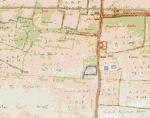 | March, Sat & Sun 29th & 30th 2014, Field Walking and Map Analysis at Sittingbourne in Kent. |
Field work at its most basic involves walking across the landscape recording features seen on the ground. On this weekend course we are concerned with recognising and recording artifacts found within the plough soil. These will include prehistoric flint tools and Roman pottery. One of the uses of field walking is to build up a database for large-scale regional archaeological surveys. We will consider the importance of regressive map analysis (left) as part of this procedure. The course will cover standard and non-standard linewalking, grid walking, pottery distribution, identifying pottery and artifacts. Free to members. £50 for non-members |
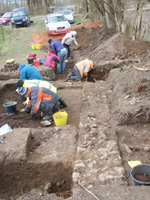 | Easter, April 18th to April 27th 2014. Excavation of and Investigation of a newly-discovered Roman villa at Teston, west of Maidstone in Kent |
Our second season of investigation of this potentially stupendous Roman building on the banks of the River Medway just west of East Farleigh in Kent. A recent geophysical survey has indicated a large and important Roman villa complex overlooking the river which has not been previously investigated. Work done in 1872 exposed a large bath house which may bepart of the main villa or could have been another associated building. The villa complex seems to cover a wide area and there are reports of a mosaic pavement being uncovered in recent years. Our investigations will include an additional geophysical survey to see how many other Roman buildings remain to be discovered!
KAFS member's special fee £20 per day (Over five years member £10),
non-members £25 per day.
|
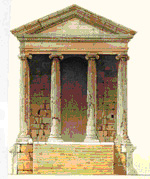 | April 12th and 13th 2013, How to Identify Roman Building Materials with Paul Wilkinson |
An opportunity to handle and have explained the essential building materials of Roman buildings. You will have the opportunity to handle the KAFS reserve collection of Roman building ceramics, painted plaster and mosaics. The course is designed to help you understand how the variety of building materials can enable you to interpret Roman buildings both in Britain and the wider Empire. Trip on Sunday to the Roman villa at Lullingstone. Cost is £50 with membership.
|
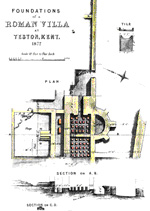 | May Bank Holiday 3rd, 4th, 5th May 2014 An Introduction to Archaeology |
On this Bank Holiday weekend and the Bank Holiday Monday we shall look at the ways in which archaeological sites are discovered and excavated and how different types of finds are studied to reveal the lives of former peoples. This course will be especially useful for those new to archaeology, as well as those considering studying the subject further. In the afternoons we will participate in an archaeological dig on a Roman villa under expert tuition. Cost is £50 with membership.
|
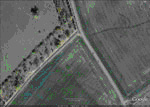 | May 17th, 18th, 2014. Aerial Survey for Archaeologists. |
"If you are studying the development of the landscape in an area, almost any aerial photograph is likely to contain a useful piece of information"
Mick Aston 2002.
A weekend spent learning about the vast archive of aerial photography available to the archaeologist. We will learn about the RCHME collection, the English Heritage collection at the NMR centre in Swindon, how to interpret and how to access the wonderful aerial world of Google Earth. on Sunday afternoon we will choose an unknown archaeological site on Google Earth and travel to it by car to see what is there! Cost is £50 with membership
|
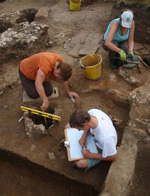 | May Bank Holiday 24th, 25th, 26th, 2014, Surveying for Archaeologists |
A Bank Holiday weekend course on the theory and practice of archaeological survey. Methods from basic optical site levels to laser technology and GPS will be taught. The work of the Ordnance Survey will be explained from the early days of triangulation using a base line to the use of GPS and its drawbacks. Practical exercises will take place at a Roman building in Teston on vertical above ground sections and plan drawing. Context sheet recording for buildings and archaeological sites will also form part of the course. Cost is £50 with membership
|
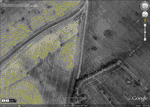 | June 28th & 29th, 2014, Landscape Archaeology |
A course designed for all those who want to know more about the English landscape. Six main categories of information will be studied: Field Archaeology, aerial photography, historic maps, local history, and place-names. Dr Paul wilkinson in the afternoons will guide us through the countryside to show how to apply archaeological theory to interpret and understand the landscape of England. Cost is £50 with membership. |
| Excavation of the Roman Emporium at Oplontis (2014)- 2nd June -13th June **Week 1 & 2 (Only seven places left 18/11/2013)**
|
Members of KAFs will be working with the University of Texas on a research excavation at the world famous palace of Nero's wife Poppaea and the adjacent shopping emporium'Villa B'. The palace was overwelmed by Vesuvius in AD79 and buried. This is an unique opportunity to join that select band of archaeologists to have excavated at the World Heritage site of Pompeii and environs. Cost is £175 a week. Accomodation and meals not included. For further details on where to book accomodation and flights email [email protected] for details |
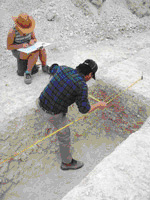 | July 12th to July 20th 2014. Excavation of Bronze Age barrows at Hollingbourne in Kent |
An opportunity to participate in the evaluation of three Bronze Age barrows on the North Downs east of Hollingbourne. The Field School excavated one of these barrows in 2012 and the second one in 2013 with a crouched burial. Further work is needed on the site to fully understand and excavate the last barrow in this sequence. KAFS member's special fee £20 per day (Over five years member £10), non-members £25 per day. Free camping is available on site
|
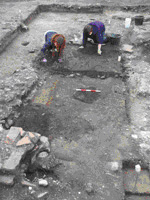 | August 2nd to 17th 2014, Excavation of a Roman villa and bath-house in Faversham |
An opportunity to participate in an important excavation of a Roman waterside building at Abbey Barns in Faversham. Originally built as an aisled building for the adjacent Roman villa it was then rebuilt as a huge bath-house. Our task for this year is to investigate the east end of the building to clarify if all the building was entirely a bath-house or whether it was attached to a domestic building. We will also investigate the waterway with augers to see if there any remains of Roman shipping and also investigate additional Roman buildings in the vicinity of the bath- house. This is an important investigation which will help to clarify the extent and importance of Roman Faversham and its harbour. KAFS member's special fee £20 per day (Over five years member £10), non-members £25 per day.
|
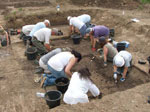 | August 11th to August 17th 2014, Training Week for Students at Faversham in Kent |
It is essential that anyone thinking of digging on an
archaeological site is trained in the procedures used in professional archaeology. Dr Paul Wilkinson, author of the best selling "Archaeology" book and Director of the dig, will spend five days explaining to participants the methods used in modern archaeology. A typical training day will be classroom theory in the morning (at the Field School) followed by excavation at Abbey Barns Roman Villa in Faversham under the guidance of trained archaeologists.
Topics taught each are:
Monday 11th August: Why dig?
Tuesday 12th August: Excavation Techniques
Wednesday 13th August: Site Survey
Thursday 14th August: Archaeological Recording
Friday 15th August: Pottery identification
Saturday and Sunday digging with the team
A free PDF copy of "Archaeology" 3rd Edition will be given to participants. Cost for the course is £100 if membership is taken out at the time of booking. Non-members £175. The day starts at 10am and finishes at 4pm. For directions to the Field School see 'Where ' on this website. For camping nearby see 'accomodation'.
For other courses see www.kafs.co.uk
|
KAFS BOOKING FORM
You can download the KAFS booking form for all of our forthcoming courses directly from our website, or by clicking here
KAFS MEMBERSHIP FORM
You can download the KAFS membership form directly from our website, or by clicking here
|

If you would like to be removed from the KAFS mailing list please do so by clicking here |
|






































